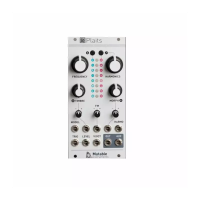Dust noise processed by networks of all-pass or band-pass filters.
HARMONICS: amount of frequency randomization.
TIMBRE: particle density.
MORPH: filter type – reverberating all-pass network before 12 o’clock, then increasingly resonant band-
pass filters.
AUX: raw dust noise.
For your own pleasure, a mini-Rings! Please refer to the Rings manual for more information about
modulated/inharmonic string synthesis, and modal resonators.
When the TRIG input is not patched, the string/resonator is excited by dust (particle) noise. Otherwise, the
string is excited by a short burst of filtered white noise, or by a low-pass filtered click.
HARMONICS: amount of inharmonicity, or material selection.
TIMBRE: excitation brightness and dust density.
MORPH: decay time (energy absorption).
AUX: raw exciter signal.
Note that Plaits uses a less powerful processor than Rings, and is thus limited to 3 voices of polyphony in
inharmonic string modeling mode, and 1 voice of polyphony with 24 partials in modal resonator mode.
Plaits does not allow you to control the position of the excitation, which is set to 25% of the length of the
string/bar/tube.
No fancy acronyms or patented technology here… Just behavioral simulation of circuits from classic drum
machines! The drum machine emulated on OUT employs a bridged T-network excited by a nicely shaped
pulse. As for the signal synthesized on AUX, it uses a frequency-modulated triangle VCO, turned into a
sine with a pair of diodes, and shaped by a dirty VCA.
HARMONICS: attack sharpness and amount of overdrive.
TIMBRE: brightness.
Mutable Instruments | Plaits
8 of 11

